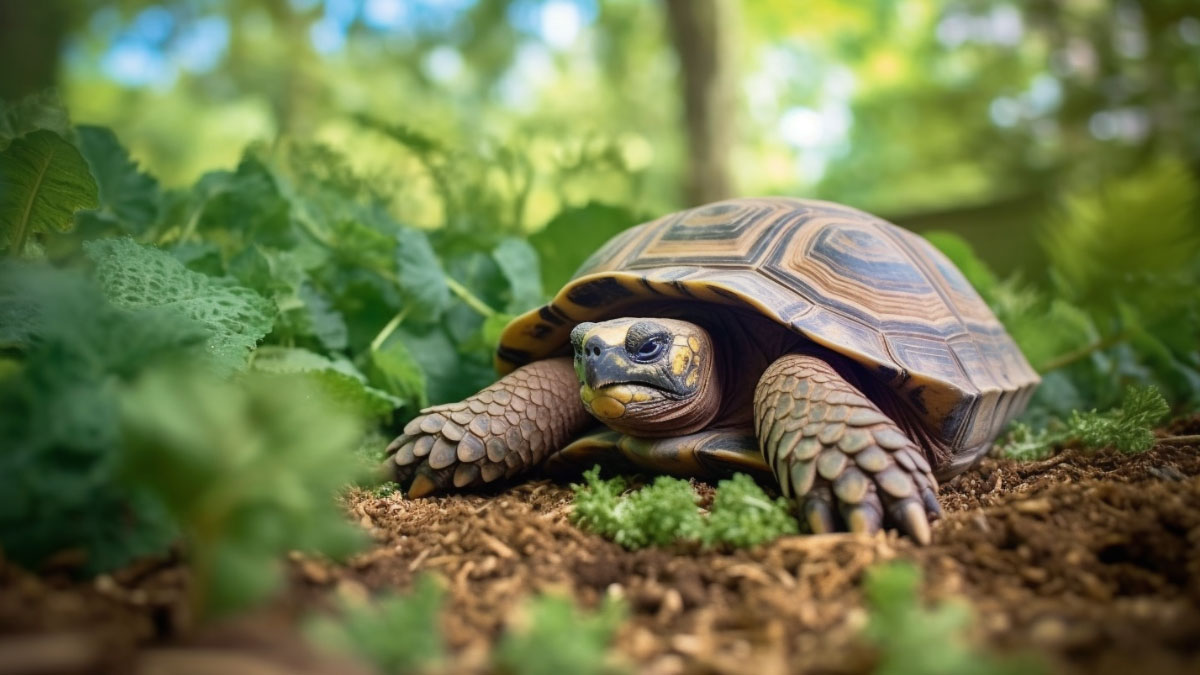Tortoise Hibernation: How, When, How Long?
Tortoise hibernation is a fascinating process that has intrigued humans for centuries. Many species of tortoises undergo hibernation as a natural response to changes in temperature and light. As a tortoise owner, it is essential to understand this process to ensure the health and well-being of your pet.
So, tortoise hibernation: how, when and how long? The answer depends on the species, age, and health. However, hibernation in the wild generally takes 6-12 weeks between November and March. In captivity, it is essential to consult with a veterinarian or an experienced tortoise keeper before deciding to hibernate your pet turtle.
This article will provide you with a comprehensive guide to tortoise hibernation. You will learn when your tortoise is ready for hibernation and how to prepare and care for your tortoise during hibernation, among other related topics.
Factors Affecting Tortoise Hibernation
Contents
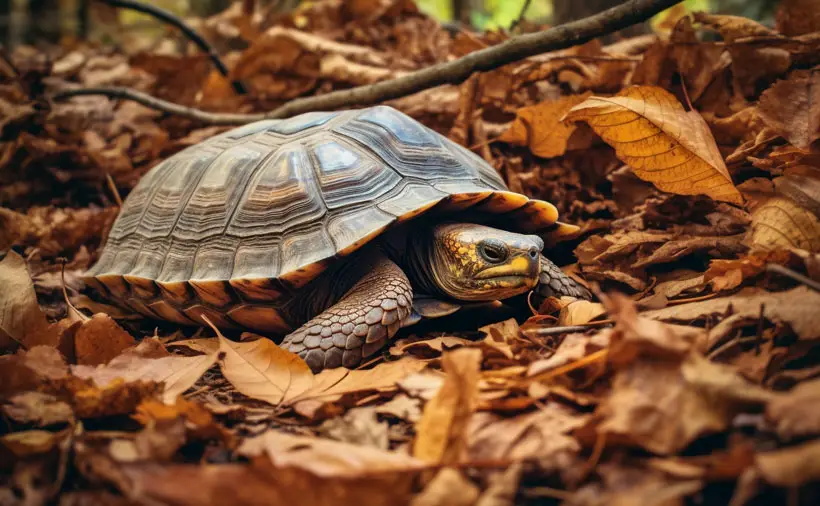
Several factors can affect a tortoise’s hibernation process. Let’s take a look at some of them.
Age
Younger tortoises may not be ready for hibernation and may need to be held back for a year or two until they have gained strength. However, depending on their health and overall condition, older tortoises may need to hibernate for a shorter period.
Health
Tortoises that are not in good health may not survive hibernation. Before hibernation, taking your tortoise to a veterinarian for a check-up is essential to ensure it is healthy and strong enough to go into hibernation. The recommended weight for a tortoise in hibernation is 2.5 to 3 kilograms.
For the Hermanns Tortoise, you can use the Jackson ratio to know if your tortoise is the recommended weight for hibernation.
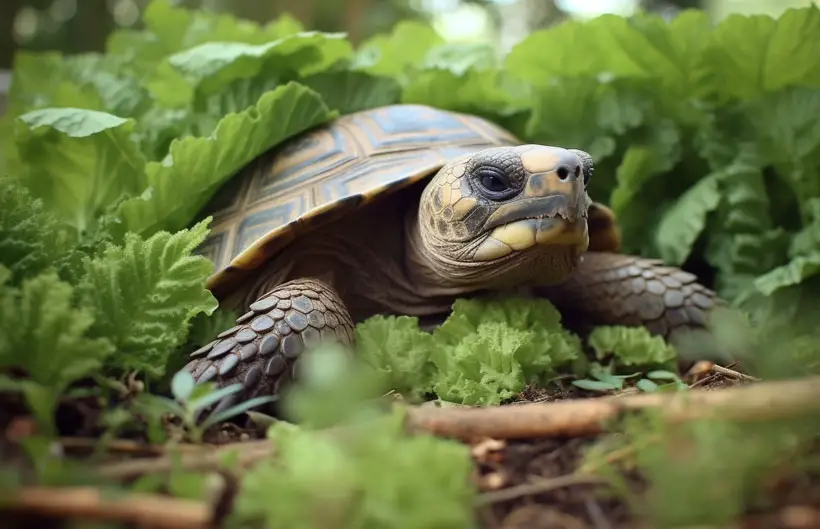
Habitat
The natural habitat of the tortoise can also affect its hibernation process. Tortoises that live in colder regions may hibernate for longer periods than those that live in warmer areas.
Species
Different tortoise species have different hibernation requirements. Some species, such as the Russian tortoise, are known to hibernate for several months, while others, such as the Sulcata tortoise, may not.
Temperature
If the temperature drops below 44.6 °F (7 °C), the tortoise will start to slow down and eventually enter a state of hibernation.
Do Tortoises Hibernate? When And How Long Do They Hibernate?
Yes, tortoises do hibernate. Hibernation is a natural process that allows tortoises and other reptiles to survive harsh environmental conditions, such as low temperatures and reduced food availability. During hibernation, tortoises conserve energy and slow down their metabolism.
They reduce their heart rate, breathing rate, and activity level to a minimum, which allows them to survive for extended periods with little or no food and water. The hibernation behavior is species-specific, with some tortoise species hibernating for months while others may not.
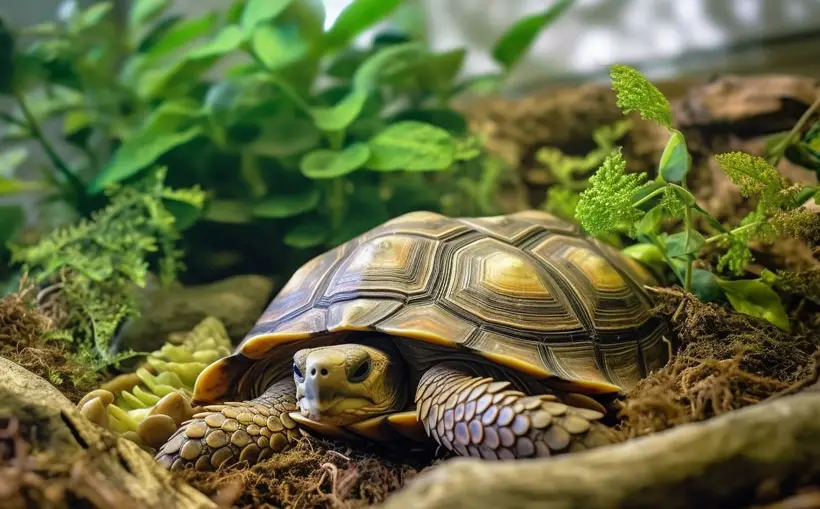
Tortoise species live in regions with pronounced seasons and temperature changes. For example, Russia, North America, and Europe, are more likely to hibernate than those in tropical and subtropical regions, such as Africa and South America.
Here is a table showing tortoise species that hibernate and those that do not.
| Tortoise Species | Hibernates? |
|---|---|
| Russian Tortoise | Yes |
| Greek Tortoise | Yes |
| Hermann’s Tortoise | Yes |
| Marginated Tortoise | Yes |
| Spur-Thighed Tortoise | Yes |
| Leopard Tortoise | No |
| Sulcata Tortoise | No |
| Redfoot Tortoise | No |
| Yellowfoot Tortoise | No |
| Desert Tortoise | No |
When And How Long Does A Tortoise Hibernate?
- Tortoises hibernate in the winter months when temperatures and daylight hours decrease.
- The exact timing of hibernation depends on factors such as species, habitat, and age.
- Generally, tortoises will start to prepare for hibernation in the late fall between November and March.
Regarding how long hibernation lasts, the answer also depends on tortoise species, age, and health.
- However, the hibernation period for tortoises generally ranges from six to twelve weeks.
If you have a pet tortoise, you should provide them with a suitable hibernation facility that mimics their natural environment. However, it is important to remember that hibernation can be dangerous and even fatal if not done correctly.
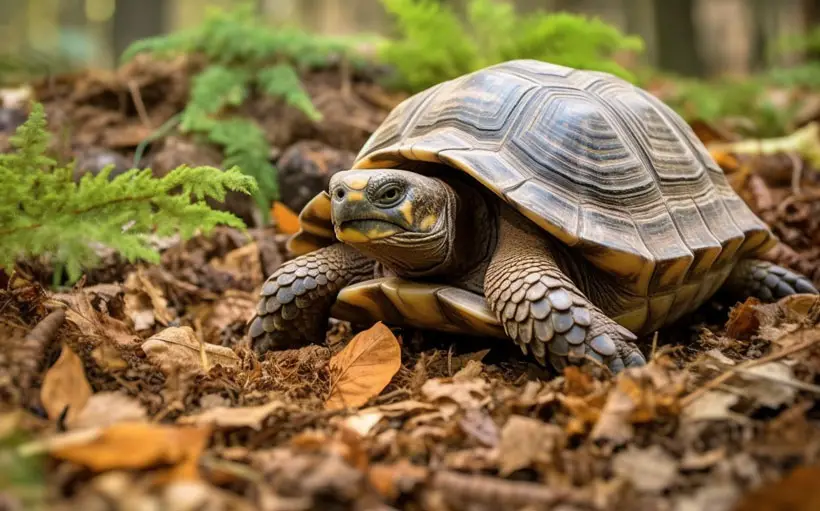
That is why it is crucial to consult a veterinarian before hibernating your pet turtle. They can help you determine if hibernation is appropriate for your tortoise and provide guidance on preparing and caring for your pet during hibernation.
How Do I Know My Tortoise Is Ready To Hibernate?
Here are some signs that your tortoise is ready to hibernate:
- Decreased Activity: Tortoises ready to hibernate will become less active and spend more time resting or sleeping. They may also eat less and become less interested in food.
- Change in Appetite: As the hibernation period approaches, tortoises will start to eat less and lose weight. This is a natural process as they prepare to slow their metabolism and conserve energy.
- Environmental Cues: Tortoises may start to respond to environmental cues that signal the onset of winter, such as decreasing daylight hours and cooler temperatures. They may start to seek out sheltered areas in their enclosure.
- Burrowing: Some tortoise species may start to burrow in the substrate of their enclosure in preparation for hibernation. This natural behavior allows them to create a safe and comfortable place to spend the winter.
How To Prepare Your Tortoise For Hibernation?
Preparing your tortoise for hibernation is crucial for ensuring a safe and successful period. Here is what to do prior-hibernation.
- Consult with a veterinarian: It is essential to consult with a veterinarian to ensure your tortoise is healthy enough to hibernate.
- Adjust their diet: Your tortoise will eat less as they prepare for hibernation. It is critical to adjust their diet to prevent them from having any food in their stomachs while hibernating.
Stop feeding them after a few weeks and give them two weeks to properly empty their tummies before hibernating.
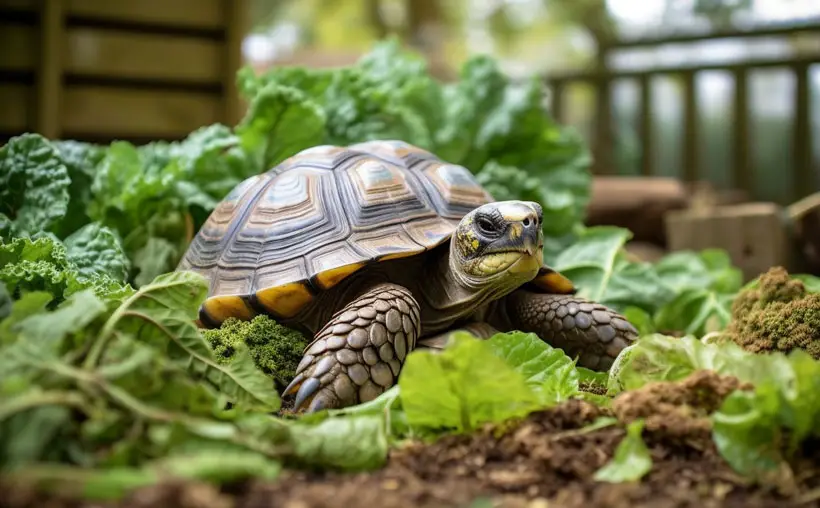
One of the most serious threats to tortoises during hibernation is food decay in their stomachs, which can lead to disease. This is why fasting for two weeks is required. Despite their scarcity of food, they must always have access to water.
- Gradually lower the temperature: Tortoises should not be subjected to sudden temperature changes, which can harm their health. Gradually lower the temperature in their enclosure over several weeks to simulate the natural temperature drop in the wild.
- Reduce exposure to light: Tortoises hibernate in the wild in dark, secluded places. To simulate this environment, reduce the amount of light your tortoise is exposed to by covering their enclosure with a towel or blanket.
- Provide a suitable hibernation area: Tortoises should hibernate in a separate enclosure from their regular living space.
The hibernation area should be large enough for your tortoise to move around but not so large that it cannot maintain a constant temperature. Line the enclosure with a suitable substrate, such as shredded paper or straw.
How To Hibernate Your Pet Tortoise?
As we have already established, hibernating your pet tortoise is a delicate process that requires careful preparation and attention to detail. Here are some methods you can use to hibernate your pet tortoise:
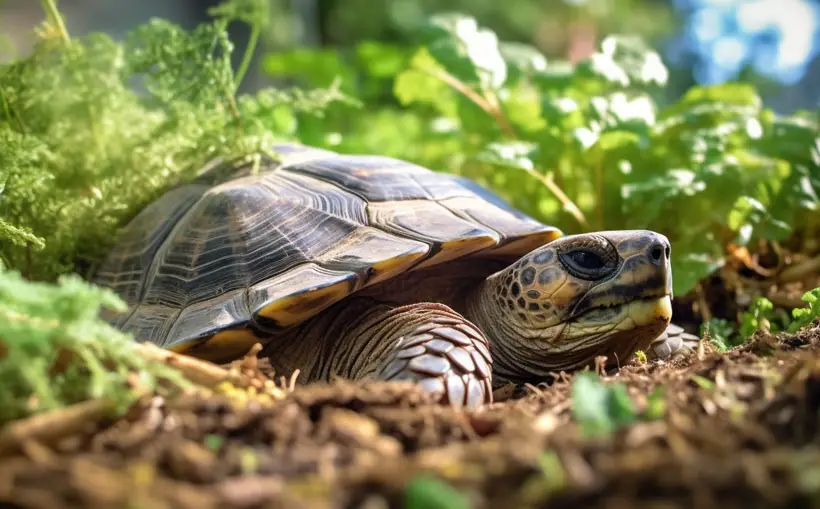
Natural Hibernation
This method simulates the natural conditions that tortoises encounter in the wild during hibernation.
- You must create a suitable hibernation area separate from your tortoise’s common living space.
- The temperature should gradually drop to around 37.4°F-60°F (3°-10°C), and the enclosure should be lined with a suitable substrate such as shredded paper or straw.
- Your tortoise will naturally slow down its metabolism and breathe less frequently, entering a state of hibernation.
Refrigeration
Refrigeration is a controlled hibernation method that involves storing your tortoise in a refrigerator for the winter months.
- You must prepare your tortoise by gradually lowering the temperature and limiting its exposure to light.
- Place your tortoise in a cardboard or plastic box with a suitable substrate and place it in the refrigerator. The temperature should be kept between 39°-46°F (4°-8°C).
This method requires less monitoring than natural hibernation, but it is critical to keep the temperature stable. Here is a video to show you more about this.
Hibernation Boxes
Hibernation boxes are another controlled hibernation method that uses a specially-designed box to hibernate your tortoise.
- The box has temperature sensors and a thermostat to ensure the temperature remains consistent.
- Set the temperature to around 50°-60°F (10°-15°C) and place your tortoise in the hibernation box with a substrate.
- This method is relatively simple to monitor and control but necessitates a substantial investment in hibernation box equipment.
How To Take Care Of Your Tortoise During Hibernation?
Now that we have discussed how to hibernate your reptile friend let us dive into how you should look at it during this inactive state.
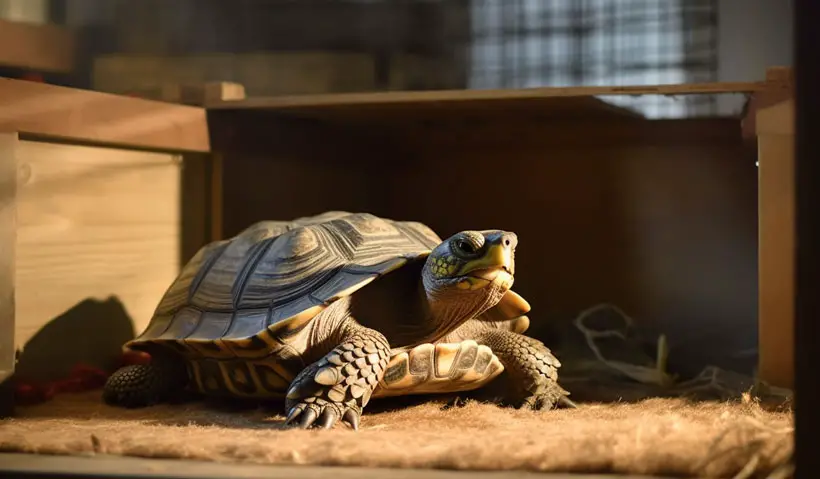
Monitor Your Tortoise During Hibernation
While it is hibernating, it is important to check on it regularly to ensure it is still alive and healthy.
- You should check on your tortoise at least once a week to ensure it is not too cold or warm.
- You should also check for any signs of illness or injury.
Weigh Your Tortoise
The best time to measure a tortoise’s weight during hibernation is before it goes into hibernation. This will give you a baseline weight to compare when it is in hibernation.
- To do this, use a scale sensitive enough to measure small changes in weight, such as a digital kitchen scale or a scale specifically designed for weighing reptiles.
- Generally, the tort will lose around 45 grams over three months.
Know When It Is Time To Take The Tortoise Out
Some situations may require bringing your tortoise out of hibernation early. These situations include:
- Significant weight loss: If your tortoise loses more than 1% of its body weight in one month during hibernation, it may indicate an underlying health issue. You may need to bring your tortoise out of hibernation early and seek veterinary attention.
- Urination: If your tortoise urinates during hibernation, it can lead to dehydration and electrolyte imbalances, which can harm the tortoise’s health.
- Activity: If your tortoise remains active in the hibernation box, it may be a sign that the temperature or humidity levels are incorrect.
- Health concerns: If your tortoise shows signs of illness or distress during hibernation, such as abnormal breathing, it may be necessary to bring it out of hibernation early.
Post-Hibernation Care
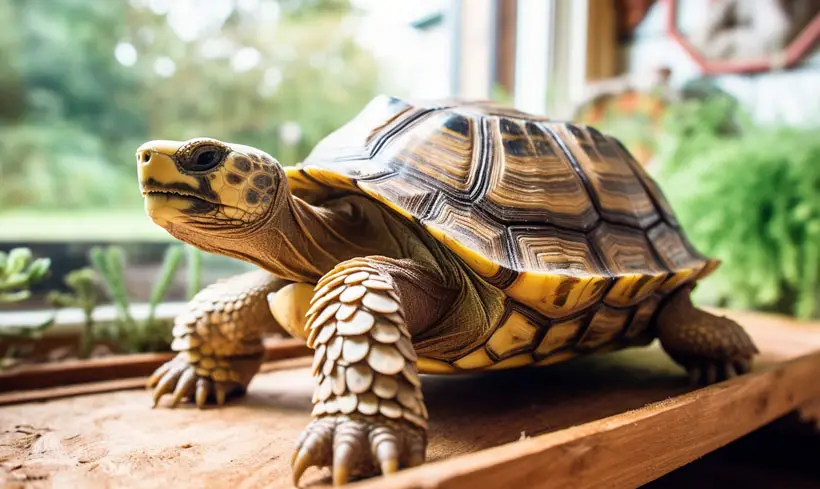
After a tortoise has emerged from hibernation, it is critical to provide proper post-hibernation care to ensure it can return to its normal routine safely and healthily. Here are some important factors to consider when caring for your tortoise after hibernation:
- Warm-up period: It is important to provide your tortoise with a warm-up period after hibernation to allow its body temperature to increase gradually.
This can be achieved by placing your tortoise in warm water. Do not place your tortoise under a heat lamp immediately after hibernation, as this can cause it to go into shock.
- Hydration: Tortoises do not drink water during hibernation, so providing your tortoise with fresh water and encouraging it to drink after hibernation is essential. You can also soak your tortoise in shallow water to help it rehydrate.
- Feeding: Reintroducing your tortoise to its regular diet gradually after hibernation is critical. Begin with small, easy-to-digest meals, such as leafy greens or fruits, and gradually increase the amount and variety of food as your tortoise’s appetite grows.
- Health check: Visiting a veterinarian specializing in reptiles is recommended to have your tortoise checked for any health issues after hibernation. The veterinarian can also advise you on any necessary treatments or medications.
- Environment: Ensure your tortoise’s enclosure is clean and has the proper temperature and humidity levels. After hibernation, your tortoise may require changes to its enclosure, such as adding more substrate or adjusting the temperature to its preferred range.
- Observation: Keep a close eye on your tortoise’s behavior and activity level after hibernation. Seek veterinary attention immediately if you notice any signs of illness or abnormal behavior, such as a lack of appetite or lethargy.
FAQs
Here are other related questions about tortoise hibernation.
Note that young tortoises should not be hibernated until they are at least a year old. Some veterinarians even advise against hibernating a tortoise that is less than three years old.
However, generally, a one-year-old tortoise should only be hibernated for three weeks, a two-year-old for six weeks, and a three-year-old for ten weeks.
Yes. A tortoise can hibernate outside, but there are some risks. Outdoor hibernation exposes your tortoise to temperature and humidity fluctuations, predators, and other hazards.
If you decide to hibernate your tortoise outside, make sure its hibernation box is well-insulated, predator-proof, and in a sheltered, weather-protected area.
Yes, a tortoise can die during hibernation if the conditions are not suitable or if there are underlying health issues. Dehydration, respiratory infections, and incorrect temperatures or humidity levels are common causes of tortoises’ hibernation-related deaths.
Conclusion
Tortoise hibernation is a natural process during the winter months in which tortoises slow their metabolism and become less active to conserve energy. To prepare your tortoise for hibernation, you must provide a suitable hibernation area or container.
This area should be well-ventilated, and the temperature should be kept within the appropriate range for your tortoise species. Caring for your tortoise during hibernation is also critical to its safety and well-being. Following this article’s advice, you can keep your tortoise healthy and ready to wake up when spring arrives.

